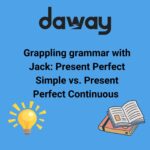Learning how to use the past tenses correctly is a key part of learning English. In today’s blog, we will explain the different uses of the past simple and past continuous and give you some key examples of how to use them.
Past simple.
The main use of the past simple is to talk about completed actions in the past, usually events that started and finished at a specific time in the past. Here are some examples:
- We played football yesterday. (Jugamos fútbol ayer)
- He didn’t do his homework last night. (Él no hizo sus deberes anoche)
- What time did you go to bed last night? (¿A qué hora te acostaste anoche?)
As you can see from the examples, for most verbs, we add -ed to the end of the base form of the verb such as play= played or jump= jumped. For many verbs that end in a consonant and a y, we substitute the y for an i such as in these cases: study= studied, try= tried, dry= dried, cry= cried.
In addition to the standard -ed and -ied ending verbs, we also have a number of irregular verbs which don’t follow the same rules as the others. This includes the verb to be (ser/estar):
| Subject | Verb |
| I, he, she, it | was(n’t) |
| You, we, they | were(n’t) |
Here are 20 more common irregular verbs and their irregular forms:
- say said (decir)
- make made (hacer)
- go went (ir)
- take took (tomar)
- come came (venir)
- see saw (ver)
- know knew (saber)
- get got (conseguir)
- give gave (dar)
- find found (encontrar)
- think thought (pensar)
- drink drank (beber)
- become became (convertirse)
- cost cost (costar)
- leave left (salir)
- feel felt (sentirse)
- put put (poner)
- bring brought (traer)
- begin began (empezar)
- Eat ate (comer)
Just like with regular verbs, to make an irregular verb negative or as a question all you need to do is add didn’t or did before the base form of the verb as you can see in this example:
- I didn’t eat pizza for dinner yesterday. (No cené pizza ayer.)
- Did they bring their homework to class? (¿Trajeron sus deberes a clase? )
Past continuous.
Like the present continuous, the past continuous is formed with both the verb to be and the ing form (the gerund) of the verb being used in the sentence.
| Subject | Affirmative | Negative | Interrogative |
| I, he, she, it | she was playing (ella estaba jugando) | she wasn’t playing (ella no estaba jugando) | was she playing? (¿ella estaba jugando? |
| you, we, they | we were playing (nosotros estábamos jugando) | we weren’t playing (nosotros no estábamos jugando) | were we playing? (¿estábamos jugando?) |
We use the past continuous to talk about:
- when an action in the past is interrupted by another action:
“I was walking to school when I saw my friend.” estaba andando al colegio cuando vi a mi amigo.
- when two actions are happening at the same time in the past:
“While I was studying for my exam my brother was playing video games.” Mientras estaba estudiando para mi examen mi hermano estaba jugando videojuegos.
- ongoing actions at a specific time in the past:
“John was playing basketball at 5 o’clock last night.” John estaba jugando baloncesto a las 5 anoche.
- emphasising the length of time an action took:
“I was trying to finish my essay for hours.” estaba intentando terminar mi ensayo por horas.
- Giving extra information or setting the background to a story:
“It was raining so I took my umbrella.” estaba lloviendo así que cogi mi paraguas.
Download the PDF of this blog with practice exercises here



